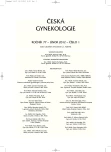To conclude knowledge about new colposcopic signs – ridge sign and inner border.
Authors:
J. Sláma
Authors‘ workplace:
Onkogynekologické centrum, Gynekologicko-porodnická klinika VFN a 1. LF UK, Praha, přednosta prof. MUDr. A. Martan, DrSc.
Published in:
Ceska Gynekol 2012; 77(1): 22-24
Category:
Original Article
Overview
Objective:
To conclude knowledge about new colposcopic signs – ridge sign and inner border.
Design:
Review article.
Setting:
Oncogynecological center, Department of Gynecology and Obstetrics, General Faculty Hospital and 1st Medical School of Charles University, Prague.
Methods and results:
Recently updated colposcopic classification includes two new colposcopic signs – ridge sign and inner border. Both are mainly present in lesions associated with oncogenic human papillomaviruses infection. Ridge sign represents thick opaque acetowhite epithelium irregularly growing in the squamocolumnar junction as ledges. Inner border is a sharp acetowhite demarcation within a less opaque acetowhite area. The sensitivity and specificity for detection of underlying high-grade lesion is 33.1% and 93.1% in ridge sign and 20% and 97% in inner border sign respectively.
Conclusions:
Ridge sign and inner border are new colposcopic signs, which improve sensitivity and specificity of colposcopic examination.
Key words:
CIN, colposcopy, ridge sign, inner border.
Sources
1. Burghardt, E., Girardi, F., Pickel, H. Coposcopy – Cervical pathology. 3rd ed. London: George Thieme Verlag, 1998, 323 p.
2. Hellberg, D., Nilsson, S. 20-year experience of follow-up of the abnormal smear with colposcopy and histology and treatment by conization or cryosurgery. Gynecol Oncol, 1990, 8, p. 166-169.
3. http://www.ifcpc.org/documents/nomenclature7-11.pdf
4. Jeronimo, J., Schiffman, M. Colposcopy at a crossroads. Am J Obstet Gynecol, 2006, 195, p. 349-353.
5. Kierkegaard, O., Byrjalsen, C., Hansen, KC., et al. Association between colposcopic findings and histology in cervical lesions: The significance ot the size of the lesion. Gynecol Oncol, 1995, 57, p. 66-71.
6. Reid, R. Biology and colposcopic features of human papillomavirus-associated cervical disease. Obstet Gynecol North Am, 1993, 20, p. 123-151.
7. Reid, R., Scalzi, P. An improved colposcopic index for differentiating benign papillomaviral infections from high-grade cervical intraepithelial neoplasia. Am J Obstet Gynecol, 1985, 15, p. 611-618.
8. Scheungraber, C., Glutig, K., Fechtel, B., et al. Inner border - a specific and significant colposcopic sign for moderate or severe dysplasia (cervical intraepithelial neoplasia 2 or 3). J Low Genit Tract Dis, 2009, 13, p. 1-4.
9. Scheungraber, C., Koenig, U., Fechtel, B., et al. The colposcopic feature ridge sign is associated with the presence of cervical intraepithelial neoplasia 2/3 and human papillomavirus 16 in young women. J Low Genit Tract Dis, 2009, 13, p. 13-16.
10. Turyna, R., Sláma, J. Kolposkopie děložního hrdla. Praha: Galén, 2009, 173 s.
11. Zahm, DM., Nindl, I., Greinke, C., et al. Colposcopic appearence of cervical intraepithelial neoplasia is age dependent. Am J Obstet Gynecol, 1998, 179, p. 1298-1304.
Labels
Paediatric gynaecology Gynaecology and obstetrics Reproduction medicineArticle was published in
Czech Gynaecology

2012 Issue 1
Most read in this issue
- Is the hysteroscopy the right choice for therapy of placental remnants?
- To conclude knowledge about new colposcopic signs – ridge sign and inner border.
- Risk factors for recurrent disease in borderline ovarian tumors
- The psychosocial needs of newborn children in the context of perinatal care
